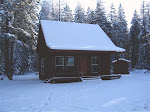
The primary bed in the Nash is a full-sized pullout couch-to-a-bed called a "gaucho bed", and for sleeping, this gaucho bed sucks. Kinda odd how a good company like Northwood can make such a fine travel trailer BARELY sleepable beds. I supposed it's for sitting comfort that the density of the seat foam is different that that of the back foam. The problem it that when folded out, that crappy back foam becomes the bed support for one of two people. I found that out the first night driving it home, when I sank down to the plywood and felt like I was in a hotdog bun all night. And, because of the crater I created, Deb was obliged to fall into that abyss as well. So we both ended up in the hotdog bun. Cuddly, but not good for sleeping. The other bed, the dinette-to-a-bed that Kyle sleeps on, doesn't have the problem, because the main cushions are pretty firm.
OK, simple solution. We bought a good full size Coleman air bed. So on camping night one, we pulled out the crappy cushions and stick them in the over head, inflate the airbed, and we're good. Deb and I sleep in a full bed at home. We've also slept in airbeds. We found that there is a difference, however, between queen and full airbeds. There is a lot more "bodily interaction" on a full airbed than a queen airbed ... and I'm not talking about the good kind of interaction. I'm heavier that Deb, so I push the air down, which pushes her up onto a hill, which causes her to tend to roll to center. Cuddly, but not good for sleeping. Anyway, the airbed idea wasn't a great solution.
Plan B.
So back to researching options. We looked at toppers, but that wouldn't alleviate the problem with the uber-soft back foam. We looked at replacing the whole cushion foam set with a futon mattress, but decided that it wouldn't fold properly into a couch form. Some people actually leave the couch folded out in the bed position full time and plop a regular mattress on top. Comfortable, but it completely eliminates the positives of the great floor space in the Nash.
So the correct solution, albeit not the cheapest, is to replace all of the cushion foam entirely. After extensive internet research boning up on the technical aspects of foam, we headed off to the local fabric and foam store to test different foams in the prone, supine and fetal positions. For the sake of this discussion, we're talking polyurethane foam, not latex or other materials.
So as we sat and layed around the store, testing foam samples, we came to the conclusion that our existing cushion SEATS are probably a medium density - medium firmness foam, and the seat BACKs are low/low. The clerk had us test a piece of "on sale" medium firm foam* that flattened right to the floor when we layed on it. So cheap foam is definitely cheap. Finally we agreed that we liked a density around 2.8 and a firmness of around 40. This will make a nice firm mattress, and a hard couch - particularly the backs - but sacrifices need to be made. That store's prices were a little high, so we decided to order via internet.
We ordered all 7 cushion pieces to complete the 52 x 75" gaucho bed from foamonline.com. We ended up with a high resilience foam, with a density of 3.0 and an ILD firmness of 40. Their prices weren't quite the lowest, but they seemed to get good reviews and gave a lot of helpful specs on the their foam, so I tend to trust them more than the cheapest. They do offer free shipping, which helps. Cost was $328 shipped.
We also bought three Alps Mountaineering dual foam pads, which are basically egg crate foam laminated to a high density foam backing. We initially bough one for Kyle as a test and found that these did a great job to soften the feel of a firm foam mattress. So we bought two more. On sale at REI.
So our next camping trip is in late April, when we can test our new foam mattress ... hopefully if we get it by then.
--------------------------------------------------------------------------------------------------------
THE TECHNICAL STUFF
* There are three primary ways to measure foam: DENSITY, FIRMNESS, and RESILIENCE. You can have a high density foam with low fimness, or visa versa. See technical stuff below.
Density is measured in pounds per cubic foot. (lb/cf3). The higher the number the better the quality and the longer it will last. I think of this as the % of foam to bubbles. A low density foam starts around 1 lb/cf3, and high density is around 3 lb/cf3. A cubic foot of medium density foam will weight about 2 pounds.
Firmness, believe it or not is not directly related to density.Firmness is measured in ILD units (Impression Load Deflection), and is measured by taking a disc and pressing into the foam. The more strength the foam has to push the disc back up is its ILD, which is stated as a number value. The higher the number, the stronger the push, so a 30 ILD is stronger than a 15 ILD. A "soft" cushion has an ILD around 15, whereas a very firm cushion has an ILD around 55.
Resilience has to do with the foam's ability to "spring back". A steel ball is dropped vertically on to a test piece and the rebound height measured and expressed as a percentage of the height dropped. As far as I can tell, you can either get high resilience (HD) or regular. HD foam has a resilience above 50%, so that steel ball dropped on it from 24" will bounce back 12".


